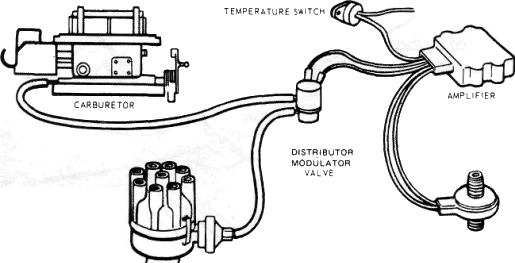Maverick and Comet Repair
Emission Controls
Electronic Spark Control System
1972 Mavericks and Comets manufactured for sale in California
equipped with a 302 V8 and automatic transmission, and all 200
six-cylinder models equipped with automatic transmission are
equipped with an Electronic Spark Control System.
Electronic Spark Control is a system which blocks off carburetor vacuum to the distributor vacuum advance mechanism under certain temperature and speed conditions. The Electronic Spark Control System consists of four components: a temperature sensor, a speed sensor, an amplifier, and a distributor modulator vacuum valve. The system serves to prevent ignition timing advance (by blocking off carburetor vacuum from the distributor vacuum advance mechanism) until the car reaches a speed of 35 mph when the ambient temperature is over 65°F.
The temperature sensor, which is mounted on the front face of the right door pillar, monitors the outside air temperature and relays this information to the amplifier. The amplifier, which is located under the instrument panel, controls the distributor modulator vacuum valve. The modulator valve, which is attached to the ignition coil mounting bracket, is connected into the carburetor vacuum line to the distributor, and is normally open. If the temperature of the outside air is below 48°F, the contacts in the temperature sensor are open and no signal is sent to the amplifier. Since no signal is sent to the amplifier, the amplifier does not send a signal to the distributor modulator valve, and the vacuum passage from the carburetor to the distributor vacuum advance remains open.
When the outside temperature rises to 65°F or above, the contacts in the temperature sensor close, and a signal is sent to the amplifier. The amplifier relays the message to the distributor modulator, which closes to block the vacuum passage to the distributor, preventing ignition timing advance.
When the ambient temperature is 65°F or above, ignition timing advance is prevented until the amplifier receives a signal from the speed sensor that the speed of the vehicle has reached 35 mph, and the distributor modulator vacuum valve can be opened to permit ignition timing advance.
The speed sensor is a miniature generator which is connected to the speedometer cable of the car. As the speedometer cable turns, the inside of the speed sensor turns with the speedometer cable. As the speed of the car increases, a rotating magnet in the speed sensor induces an electronic current in the stationary windings in the speed sensor. This current is sent to the amplifier. As the speed of the vehicle increases, the amount of current sent to the amplifier by the speed sensor increases proportionately. When the car reaches a speed of 35 mph, the amplifier signals the distributor modulator vacuum valve to open, allowing carburetor vacuum to be sent to the distributor vacuum advance chamber. This permits the ignition timing to advance. It should be noted that this system operates only when the ambient temperature is 65°F or above, and then only when the speed of the car is below 35 mph.

Electronic spark control system schematic
Transmission
Regulated Spark System
All 1972 Mavericks and Comets
equipped with a 170 or 200 six-cylinder engine and manual
transmission use a Transmission Regulated Spark Control System.
The Transmission Regulated Spark Control System (TRS) differs from the Dist-O-Vac and ESC systems in that the speed sensor and amplifier are replaced by a switch on the transmission. The switch is activated by a mechanical linkage which opens the switch when the transmission is shifted into High gear. The switch, when opened, triggers the opening of the vacuum lines to the distributor, thus providing vacuum advance. So, in short, the TRS system blocks vacuum advance to the distributor only when the outside temperature is above 65°F and the transmission is in First or Second gear.
